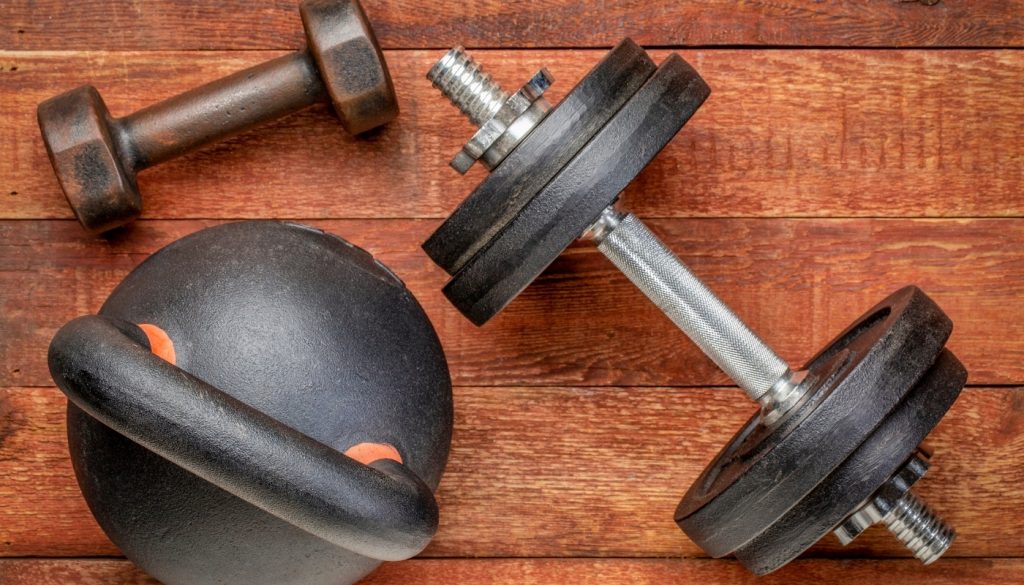Dumbbells and kettlebells are the two most used and effective pieces of equipment in any gym. Both offer a huge range of benefits to any workout, and although they are similar in design, they each provide different benefits to your workout. Each is suited for different muscle groups and the type of movement.
But the most common question is:
Which is better? How do you choose? Most importantly, which one is the best for you and your fitness goals?

A dumbbell consists of two equal weights that are attached to a handle, and the weights can be fixed or adjustable.
They usually have knurled or textured handles to make them easier to grip, and most exercises involve holding the dumbbell in the middle of the handle, which helps ensure the weights remain balanced.
Dumbbells are easier to use than kettlebells, which makes them a great choice if you’re just getting started in the weight-training game. Dumbbells are usually the better choice for moves that require “pressing and pulling,” because dumbbells help you feel more stable.
Dumbbell weights tend to increase in small increments, such as 2.5 or 5 lbs. This is useful for progressive resistance training and means you can make your workouts gradually harder over time. Dumbbell exercises target specific muscle groups like your biceps and triceps, among many others.
Dumbbells are great for bilateral training—working both sides of the body at the same time, such as in bicep curls or lateral raises. They are a great way for beginners to learn the basics of strength training and see improved physical performance.
You can start with more basic movements like lateral raises, biceps curl, lunges, or squats.

Biceps curl
Hold a pair of dumbbells in front of your thighs with your palms facing out. Slowly curl the dumbbells up to your chest and then back down again.

Lateral raises
Stand holding a dumbbell in each hand next to your outer thighs. Keep your back straight and slowly lift the weights out to the sides until your arms are parallel with the floor. Your elbows should be slightly bent. Slowly lower the dumbbells back to the starting position.

Chest press
Lie on a bench or on the floor with a dumbbell in each hand and position your arms at 45-degree angles with your palms facing forward. Slowly push the dumbbells upward and slightly inward toward the chest, so that when you get to the top of the movement, the weights almost meet. Hold at the top for a beat. Slowly lower the dumbbells back down to the starting position.

Weighed reverse lunges
Kick your lunges up a notch by adding some weight into the mix. Hold a dumbbell in each hand, and take a big step back with one leg. Drop down into your lunge, making sure that your front knee stays behind your toes, then drive up through your front foot to return to stand and repeat on the other side.

Overhead Triceps Extention
Hold a weight over your head, using both hands. Keep your upper arms close to your ears and your elbows forward. Slowly lower the weights until your elbows are at a 90-degree angle. Slowly bring the weight back up to the starting position.

A kettlebell has one large, spherical weight with a handle on top, while dumbbells feature two equal-sized weights with a bar in the middle.
Kettlebell weights tend to increase in larger jumps than dumbbells, typically 9-18 lbs./4-8 kilograms. If you’re looking for some higher-intensity weight training, reach for a kettlebell.
Kettlebells are often used for the top goals in fitness including strength and power. Kettlebells exercises tend to be fast, explosive, and better for overall body strength and conditioning. They offer a slight edge in design effectiveness and energy usage during functional movements.
Using a kettlebell, with the handle design putting most of the pressure on your wrists, will activate an entirely different set of muscles and stabilizers. They are better for moves like swings, cleans, and snatches because of the way the load is distributed.
The swinging action of kettlebells creates a fluid movement, which may be easier on the body. Because of the extra movement involved in the standard exercises, kettlebells provide a better cardio workout.

Kettlebell swings
Stand with feet set wider than shoulder-width and bend your knees to grab the kettlebell with both hands. Drive your hips, keep your back flat swing the weight up to shoulder height. Return to the start position and repeat without losing momentum.

Overhead press
Start by holding a kettlebell at chin height with your wrist straight and your elbow directly below your wrist. Press the weight directly overhead, then lower it slowly under control. If you can’t control the kettlebell, you either have weak wrists or are trying to press in an inefficient path.

Deadlifts
Start standing with your feet hip-width apart, your weight shifted back in your heels. The kettlebell should be on the floor a few inches in front of you. Hinge at your hips and push into your heels as you bend to grab the kettlebell with both hands. Make sure your back stays flat. Drive your hips forward and lift the kettlebell as you stand up, keeping your weight pushed through your heels.

Squats
Stand with your legs slightly wider than shoulder-width apart, clasping a kettlebell in each hand in front of your chest with palms facing each other. Bend your knees and lower yourself into a squat, keeping the kettlebells in the same position and ensuring you don’t round your back by tensing your glutes throughout. Drive back up and repeat.

Single arm kettlebell rows
Place a kettlebell in front of you. Place your right leg forward and rest your left leg on the ball of your left foot. Bend your knees slightly as you bend over to get in the starting position. Keep your back straight. Rest your right hand on your right knee for stability. Grip the kettlebell with a neutral grip in your left hand. Pull the kettlebell up to your stomach, retracting your shoulder blade and flexing your elbow. Keep your back straight. Lower and repeat. Complete all the repetitions for one side before switching.




